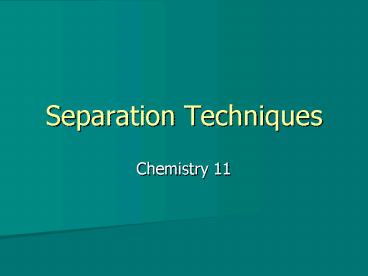Separation Techniques PowerPoint PPT Presentation
1 / 18
Title: Separation Techniques
1
Separation Techniques
- Chemistry 11
2
- ALL of the following techniques (after this
slide) only separate MIXTURES (not compounds) - The mixtures are separated based on differences
in physical properties, not chemical reactions - Electrolysis could be used to separate compounds
by breaking the bonds in the molecules
3
Hand Separation / Mechanical Separation
- mechanical mixture can often be separated by hand
or by the use of a sieve or magnet.
4
Settling
- Uses gravity to pull denser particles to the
bottom of a mixture
- Special Case Centrifugation
- Uses a machine (centrifuge) to spin the sample at
high speeds to pull the particles down faster
5
Filtration
- Allows the separation of solids from liquids or
gases - Ex. Air filters
- The solid which remains behind on filter paper is
called the residue - The liquid which passes through filter paper is
called the filtrate
6
Filtration Continued
- NOTE
- Filtration cannot be used to separate dissolved
solids from a liquid. - Filtration only works when the solid particles
present are big enough to be seen smaller
particles (such as dissolved salt) simply pass
right through the filter paper.
7
Extraction
- Two Types
- Extraction of a solid from a mechanical mixture
of solids - Extraction of a dissolved liquid or solid from a
liquid solution
8
1. Extraction of a solid from a mechanical
mixture of solids
- Uses a liquid to dissolve one or more of the
solids present but leaves others undissolved - Ideally only two solids will be present so that
the desired solid is either - i) Left behind, or
- ii) Dissolved and subsequently separated
- by simple evaporation of the solvent.
9
A couple of definitions
- Two liquids are MISCIBLE if they are mutually
soluble in each other in all proportions - ie. the liquids mix together
- Two liquids are IMMISCIBLE if they are insoluble
in each other (form two phases) - ie. The liquids dont mix together
- Note liquids can be partially miscible
10
2. Extraction of a dissolved liquid or solid from
a liquid solution
- A solvent is added that
- is immiscible with the solvent already present
- dissolves one or more desired substances from the
solution and leaves unwanted substances behind
(or vice versa) - Two solvent layers form and are separated using a
separatory funnel - Process may need to be repeated to remove more of
the desired component
11
Distillation
- Uses differences in boiling point to separate two
or more liquids - The liquids are heated
- Liquid with lowest boiling point evaporates first
- This vapour is cooled and collected and called
the distillate - This process gives good results as long as the
boiling points of the liquids are not too close
together
12
(No Transcript)
13
Evaporation
- separates solids or dissolved solids from liquid
by removing the liquid - Can wait for the liquid to evaporate or boil it
off
14
Recrystallization
- causes a dissolved solid to crystallize in a pure
state - commonly used to purify solids
- Dissolve solid in minimum hot solvent possible
- Cool down the solution or evaporate off the
solvent slowly to cause the solid to reform
without the impurities in the solid that were
present before
15
Chromatography
- Used to separate multiple dissolved solids from a
liquid solution - Multiple types
- We will look at paper chromatography as our
example - 3 components
- Mobile phase (developing solution)
- Stationary phase (paper)
- Analyte (chemicals being analyzed)
16
Paper Chromatography
- analyte (dissolved solids) are put on the
chromatography paper at a marked location - Paper is put into a developing solution (a
solvent that will carry the analyte up the paper) - The different solids interact with the paper
differently - The solids that interact strongly are harder to
move up the paper and are separated out first - Weaker interacting solids travel farther up the
paper
17
- After some time passes, the paper is removed from
the developing solution and the solvent front
is marked - Solvent front is the farthest point the solvent
moved to - By analyzing how far the dissolved solids
traveled compared to how far the solvent front
moved (as well as other properties) the solids
can sometimes be identified - Rf distance substance traveled
- distance solvent front traveled
18
Paper Chromatography

